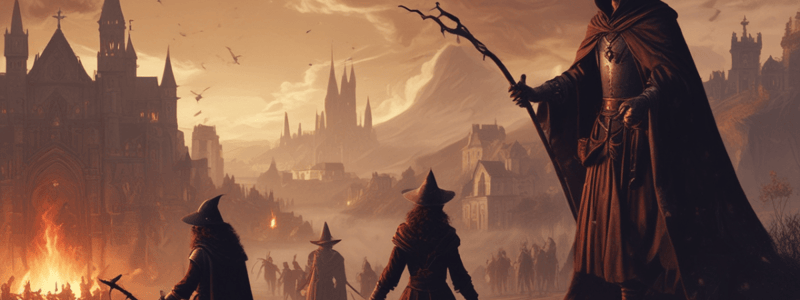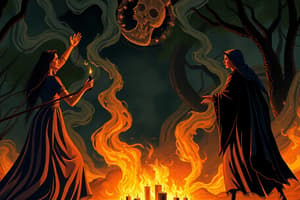Podcast
Questions and Answers
What was a primary factor in the development of the witch craze in 16th and 17th century Europe?
What was a primary factor in the development of the witch craze in 16th and 17th century Europe?
- The adoption of herbal medicine practices
- The conflict between Catholics and Protestants (correct)
- The spread of witchcraft as a belief system
- The publication of the Malleus Maleficarum
What was a common motivation behind accusing someone of witchcraft during the 16th and 17th centuries?
What was a common motivation behind accusing someone of witchcraft during the 16th and 17th centuries?
- To eliminate competition in herbal medicine practices
- To settle personal vendettas
- To scapegoat marginalized groups
- All of the above (correct)
How did the Little Ice Age contribute to the witch craze?
How did the Little Ice Age contribute to the witch craze?
- It led to increased crop yields and better harvests
- It had no impact on the witch craze
- It caused widespread famine and poverty
- It fostered a climate of fear and desperation (correct)
What was the primary purpose of the Malleus Maleficarum?
What was the primary purpose of the Malleus Maleficarum?
What was a common characteristic of those accused of witchcraft during the 16th and 17th centuries?
What was a common characteristic of those accused of witchcraft during the 16th and 17th centuries?
What was a common belief about witchcraft during the 16th and 17th centuries?
What was a common belief about witchcraft during the 16th and 17th centuries?
What was the primary purpose of the Malleus Maleficarum?
What was the primary purpose of the Malleus Maleficarum?
What was a common characteristic of many accused witches?
What was a common characteristic of many accused witches?
What was a major consequence of the Reformation in relation to the witch craze?
What was a major consequence of the Reformation in relation to the witch craze?
What were some of the suspected abilities of witches according to popular belief?
What were some of the suspected abilities of witches according to popular belief?
What was a common result of accusations during the witch craze?
What was a common result of accusations during the witch craze?
What was a major factor contributing to the witch craze in the 16th and 17th centuries?
What was a major factor contributing to the witch craze in the 16th and 17th centuries?
What was the purpose of terrorizing ordeals like swimming tests during the witch trials?
What was the purpose of terrorizing ordeals like swimming tests during the witch trials?
Which of the following groups played a significant role in the witch trials?
Which of the following groups played a significant role in the witch trials?
What was the typical punishment for convicted witches?
What was the typical punishment for convicted witches?
What contributed to the subsiding of the witch craze in the late 17th century?
What contributed to the subsiding of the witch craze in the late 17th century?
What was King James I's role in the witch craze?
What was King James I's role in the witch craze?
What was the underlying purpose of the witch trials beyond the fear of magic?
What was the underlying purpose of the witch trials beyond the fear of magic?
What legacy did the witch craze leave on modern society?
What legacy did the witch craze leave on modern society?
What should be mentioned when focusing on witch hunts in Europe?
What should be mentioned when focusing on witch hunts in Europe?
Flashcards are hidden until you start studying
Study Notes
What is Witchcraft?
- Witchcraft was a belief system centered around individuals who supposedly possessed magical powers.
- These powers could be used for good or evil, depending on the witch's intentions.
- Popular beliefs included curses, healing, communication with spirits, and the ability to control the weather.
- Many accused witches were ordinary people, often women, who might have practiced herbal medicine, held unpopular views, or simply lived on the fringes of society.
The Seeds of Fear: A Perfect Storm for Persecution
- The Reformation, a period of religious conflict between Catholics and Protestants, fostered a climate of fear and suspicion.
- The Little Ice Age, a period of harsh winters and poor harvests, led people to blame witches for manipulating the weather and causing hardship.
- The Malleus Maleficarum, published in 1487, detailed how to identify and prosecute witches, fueling paranoia and providing a "witch-hunting handbook" for authorities.
- Social and Political Tensions: The witch craze often served as a way to scapegoat marginalized groups, settle personal vendettas, or deflect blame from ruling elites.
The Accusation Frenzy and the Ordeals
- Accusations could be based on rumors, jealousy, or simply misfortune.
- Terrifying ordeals, like swimming tests, were used to "prove" guilt.
- These ordeals were deeply flawed and often resulted in false confessions under immense pressure.
The Persecution Machine: The Inquisition and Punishment
- The Catholic Church, particularly through the Inquisition, played a major role in witch trials.
- Protestant regions also participated in the persecution.
- Punishments for convicted witches were brutal, ranging from exile to torture and execution by burning at the stake.
The End of the Craze: A Shift in Thinking
- The witch craze gradually subsided in the late 17th century.
- Scepticism, Enlightenment Thinking, and King James I of England's book questioning witch trials contributed to the decline.
- King James I, initially a supporter of witch hunting, later authored a book questioning the practices.
Remember
- The witch craze was a complex phenomenon fueled by fear, religious turmoil, and social anxieties.
- It wasn't just about magic; it served as a way to control, punish, and scapegoat marginalized groups.
- The witch trials are a dark reminder of the dangers of religious intolerance and the importance of critical thinking.
Studying That Suits You
Use AI to generate personalized quizzes and flashcards to suit your learning preferences.




